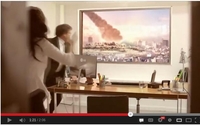LG's Sudden Impact
- by Thom Forbes @tforbes, September 9, 2013
 LG Electronics -- until recently an obscure OEM based in Korea in the eyes of most American consumers
-– is generating some strong views about, well, views lately. Its latest foray into the headlines is a LG
video-gone-viral that prompted an Adweek “Ad Freak” headline to ask: “Is This the Most Evil and Sadistic Prankvertising Stunt
Yet?”
LG Electronics -- until recently an obscure OEM based in Korea in the eyes of most American consumers
-– is generating some strong views about, well, views lately. Its latest foray into the headlines is a LG
video-gone-viral that prompted an Adweek “Ad Freak” headline to ask: “Is This the Most Evil and Sadistic Prankvertising Stunt
Yet?”
“The electronics giant took to Chile recently to shoot a hidden-camera prank commercial,” reports the Los Angeles Times’ Salvador Rodriguez, in which it “replaces the window in an office of a high-rise building with one of its Ultra HD TVs.” The new LCD technology is said to deliver four times the resolution of regular HD TVs.
advertisement
advertisement
With hidden cameras rolling, job applicants file in and take a seat before potential employer. “But in the middle of the interview, a bright light starts to shine out of the top left corner of the TV, and, slowly, a meteor creeps into view,” Rodriguez continues. “The job seekers try to keep calm as long as possible, but eventually they all freak out.”
“It could be the end of the world,” writesUSA Today’s Bruce Horovitz. “Or maybe it’s just the end of marketing as we know it.” He goes on to suggest that the success of the video (more than 7.5 million views in a week as of this morning) “could kick-start a slew of marketers to try similar so-called prankvertisements.”
At least two academic observers agree that “scaring the beejeebers” out of people is an effective way to reach an audience nowadays. “Intensity is the new black,” opines Kit Yarrow, a consumer research psychologist and chairman of the Department of Psychology at Golden Gate University. “For marketers to get attention, the intensity has to be ramped up.”
And George Belch, a professor of marketing at San Diego State University, says: “I’m hard-pressed to name a major marketer who has done an online video with this kind of impact.”
On the public relations front, LG is battling environmentalists, view preservationists and just plain folk like Larry Rockefeller who feel that its new U.S. headquarters building in Englewood Cliffs, N.J. will ruin the view of the Palisades from Manhattan. A judge has ruled that a zoning variance granted by local officials allowing the building to exceed the previous 35-foot high limit is legal, and Bergen County Freeholders voted last week in support of the plan, reports NJ.com.
LG says the project will generate lots of jobs and money for the local economy, and immediate neighbors prefer the added height with underground parking and surrounding trees to an alternative plan that would purportedly involve a sprawling car lot at eye level, according to a report by Amy Eddings on WNYC.
“Saving the Palisades has been a cause célèbre since the late 1800s, when threats from quarries and advertising on the cliffs prompted John D. Rockefeller Sr. and other powerful New Yorkers of the day to purchase and donate land to the newly-formed Palisades Interstate Park Commission,” says the New Jersey Conservation Foundation,” which is among the groups opposing the height of the new building.
The Star-Ledger Editorial Board has written, “If ever there was a moment for corporate leadership, this is it,” later suggesting that “LG should do the right thing: Revise its plans and build a lower structure.”
So where did LG come from, seemingly all of a sudden?
If you missed it, take a look at Nicholson Baker’s quest for the origins of LCD screens –- the “thin, luminous, elegant, unflickering dispenser of imagery that will make the world seem newly hosed clean and polyurethaned” -– in the July 8 & 15 issue of The New Yorker.
They started appearing in airport lounges “somewhere around 2004,” Bakers reports, and were “made by a company nobody had heard of then: LG, originally short for Lucky Goldstar.”
So Baker hops on a plane to LG Display’s factory in Paju, north of Seoul where he meets up with the “irrepressible, instantly likeable Epic Kim,” of the General Affairs Team. As he and Kim tour the factory, Baker writes, “Over and over I said, ‘That’s impressive, that’s amazing, that’s wonderful,’ and I meant it.”
The next day, Baker travels to LG headquarters in Seoul where he learns the differences between Korea’s two mega-brands in consumer electronics from Ken Hong, LG’s director of global communications, and K.S. Lee, a vice president. (Among other rivalries, “Samsung and LG are engaged in war-like competition to get the upper hand in the Curved OLED TV market,” Korea IT Times reports this morning.)
“‘If you ask people to describe the differences between LG and Samsung,’ Lee said, they generally said that LG was a warmer company. Hence LG’s color, red and its slogan, ‘Life’s Good.’ ‘Samsung is blue, relatively cold,’ Lee added, ‘but very smart, sharp, competitive.’”
That’s the view from LG Twin Towers in Seoul’s financial district at any rate. The view from Manhattan is a work in progress.

